

VM-aware storage provides better migration, performance and more. VM-aware storage is a hot topic right now in the virtualization world, according to storage and virtualization expert Stephen Foskett.
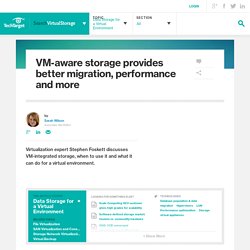
In the past year there was an increase in storage developed specifically for virtual machines. These storage systems enhance data migration, performance and integration with virtual server environments. However, some VM storage products will only work well if virtual machines are the only workloads running on it, which may not benefit organizations that haven't virtualized their entire environment. In this podcast, Foskett discusses the benefits and drawbacks of VM-aware storage, and where he sees the technology going in the future. Listen to the podcast or read the transcript below. How are vendors making VM-aware storage different from traditional storage, and what are some of the common features that can be found with it?
Stephen Foskett: That's really a major industry trend right now. That's especially true with small businesses. Virtualbox - Should I be using snapshots or clones for my purposes? Understanding Clones. Features | Documentation | Knowledge Base | Discussion Forums Prev Contents Last Next A clone is a copy of an existing virtual machine.
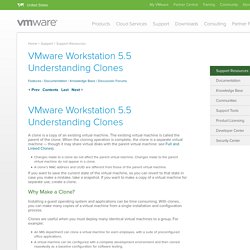
The existing virtual machine is called the parent of the clone. When the cloning operation is complete, the clone is a separate virtual machine — though it may share virtual disks with the parent virtual machine: see Full and Linked Clones). Changes made to a clone do not affect the parent virtual machine. If you want to save the current state of the virtual machine, so you can revert to that state in case you make a mistake, take a snapshot. Why Make a Clone? Installing a guest operating system and applications can be time consuming. Clones are useful when you must deploy many identical virtual machines to a group. An MIS department can clone a virtual machine for each employee, with a suite of preconfigured office applications.
Full and Linked Clones There are two types of clone: Full Clones. Continuous data protection. Continuous data protection (CDP), also called continuous backup or real-time backup, refers to backup of computer data by automatically saving a copy of every change made to that data, essentially capturing every version of the data that the user saves.
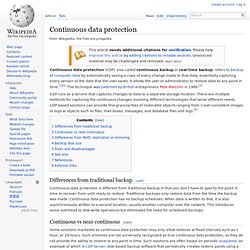
It allows the user or administrator to restore data to any point in time.[1][2] The technique was patented by British entrepreneur Pete Malcolm in 1989.[3] SAN Based replication ? no problem.. latency.. Problem.. Disaster recovery has become something which is moving higher and higher up agenda on companies “to do” list.
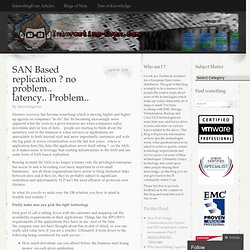
Its becoming increasingly more apparent what the costs to a given business are when companies suffer downtime and/or loss of data.. people are starting to think about the monetary cost to the business is when services or applications are unavailable to both internal staff and more importantly customers and with the big push of server virtualization over the last few years.. where is application data/file data/the application server itself sitting ? On the SAN; so it makes sense to leverage that existing infrastructure in the SAN and use some form of SAN based replication. So what do you do to make sure the DR solution you have in mind is feasible and realistic ? Copy-on-write. Copy-on-write in virtual memory management[edit] Another use involves the calloc function.
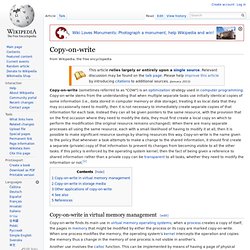
This can be implemented by means of having a page of physical memory filled with zeros. Faif.objectis. h10858-vnx-snapshots-wp.pdf. Using LVM mirroring for disaster recovery? One of the disaster recovery solutions in use by many organizations is LVM mirroring and snapshots.
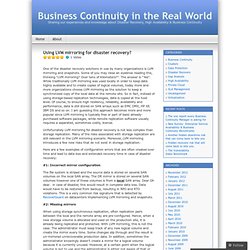
Some of you may raise an eyebrow reading this, thinking “LVM mirroring? Over tens of Kilometers?”. The answer is “Yes”. While traditionally LVM mirroring was used locally in order to keep data highly available and to create copies of logical volumes, today more and more organizations choose LVM mirroring as the solution to keep a synchronized copy of the local data at the remote site. So in fact, instead of using storage-based replication technologies, data is copied at the host level. Unfortunately LVM mirroring for disaster recovery is not less complex than storage replication. Here are a few examples of configuration errors that are often created over time and lead to data loss and extended recovery time in case of disaster recovery: #1: Incorrect mirror configuration.
Limitations of host-based mirroring for stretched clusters. For data mirroring, EMC SRDF is sometimes used in such a setup that both servers write to one location only (the “far” server writes across dark fibre links to the local storage).
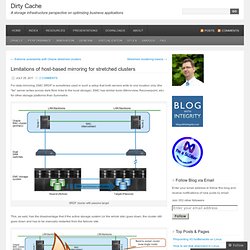
EMC has similar tools (Mirrorview, Recoverpoint, etc) for other storage platforms than Symmetrix. SRDF cluster with passive target This, as said, has the disadvantage that if the active storage system (or the whole site) goes down, the cluster still goes down and has to be manually restarted from the failover site. SRDF cluster failure recovery Host Based Mirroring A seemingly attractive alternative exists for replicating storage across multiple datacenters: Host Based Mirroring. As Oracle Automatic Storage Management (ASM) fulfills all of these requirements, many customers choose to move away from Unix style volume managers and use Oracle ASM instead.
The idea is that if a site failure happens, the cluster keeps running without recovery as storage on both locations was active anyway. License cost CPU overhead. Sakis Kasampalis (@SKasampalis) Interestingevan's Blog.